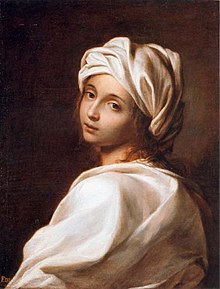Beatrice Cenci
This article needs additional citations for verification. (December 2007) |

Beatrice Cenci (February 6, 1577 – September 11, 1599) was an Italian noblewoman. She is famous as the protagonist in a lurid murder trial in Rome.
Beatrice was the daughter of Francesco Cenci, an aristocrat who, due to his violent temper and immoral behaviour, had found himself in trouble with papal justice more than once. They lived in Rome in the rione Regola, in Palazzo Cenci, built over the ruins of a medieval fortified palace at the edge of Rome's Jewish ghetto. Together with them lived also Beatrice's elder brother Giacomo, Francesco's second wife, Lucrezia Petroni, and Bernardo, the young boy born from Francesco's second marriage. Among their other possessions there was a castle, La Rocca of Petrella del Salto, a small village near Rieti, north of Rome.
History
According to the legend, Francesco Cenci abused his wife and his sons, and had reached the point of committing incest with Beatrice. He had been jailed for other crimes, but thanks to the leniency with which the nobles were treated, he had been freed early. Beatrice had tried to inform the authorities about the frequent mistreatments, but nothing had happened, although everybody in Rome knew what kind of person her father was. When he found out that his daughter had reported against him, he sent Beatrice and Lucrezia away from Rome, to live in the family's country castle. The four Cenci decided they had no alternative but to try to get rid of Francesco, and all together organized a plot. In 1598, during one of Francesco's stays at the castle, two vassals (one of whom had become Beatrice's secret lover) helped them to drug the man, but this failed to kill Francesco. Following this Beatrice, her siblings and step mother bludgeoned Francesco to death with a hammer and threw the body off a balcony to make it look like an accident. No one believed the death to be an accident.
Somehow his absence was noticed, and the papal police tried to find out what had happened. Beatrice's lover was tortured, and died without revealing the truth. Meanwhile a family friend, who was aware of the murder, ordered the killing of the second vassal, to avoid any risk. The plot was discovered all the same and the four members of the Cenci family were arrested, found guilty, and sentenced to death. The common people of Rome, knowing the reasons for the murder, protested against the tribunal's decision, obtaining a short postponement of the execution. But pope Clement VIII showed no mercy at all: on September 11, 1599, at dawn, they were taken to Sant'Angelo Bridge, where the scaffold was usually built.
Giacomo was quartered with a mallet and had his limbs hung in the four corners; then Lucrezia and finally Beatrice took their turn on the block, to be beheaded with a sword. Only the young boy was spared, yet he too was led to the scaffold to witness the execution of his relatives, before returning to prison and having his properties confiscated (to be given to the pope's own family). Beatrice was buried in the church of San Pietro in Montorio. For the people of Rome she became a symbol of resistance against the arrogant aristocracy and a legend arose: every year on the night before her death, she came back to the bridge carrying her severed head.
Literature and arts
Beatrice Cenci has been the subject of a number of literary and musical works:
- Beatrice Cenci, a novel by Francesco Domenico Guerrazzi
- Les Cenci, novel by Stendhal
- Percy Bysshe Shelley's verse drama The Cenci: A Tragedy in Five Acts (composed at Rome and at Villa Valsovano near Livorno, May–August 5, 1819, published spring 1820 by C. & J. Ollier, London, 1819)
- Béatrix Cenci, a verse drama (1839), by Polish poet, Juliusz Słowacki
- "Beatrice Cenci (In a City Shop-Window)", (1871) a poem by Sarah Piatt, American poet.
- Béatrix Cenci, by Astolphe de Custine
- Nemesis, tragedy by Alfred Nobel.
- Beatrice Cenci, a play by Alberto Moravia
- Beatrix Cenci, opera by Alberto Ginastera
- Beatrice Cenci, opera by Berthold Goldschmidt
- Les Cenci (1935), play by Antonin Artaud
- The Cenci, essay by Alexandre Dumas in Volume 1 of Celebrated Crimes
- The Cenci (1951-52), an opera by Havergal Brian (abridged from Shelley's play)
- Betarice Cenci (2006), musical drama by Alessandro Londei e Brunella Caronti (original play)
The painting of Beatrice Cenci by Mannerist painter Guido Reni (1575-1642) and the legend surrounding Beatrice figures prominently in Nathaniel Hawthorne's The Marble Faun (1860). The book's two principal female characters, Hilda and Miriam, debate the nature and extent of Beatrice's guilt. Hilda believes Beatrice's act to be "inexpiable crime" but Miriam believes it was "no sin at all, but the best possible virtue in the circumstances". Hawthorne draws many similarities between Miriam and Beatrice and the reader must debate whether or not Miriam is an avenger or a culprit.
Reni's painting also appears in David Lynch's film Mulholland Dr. (2001), shown hanging in the Hollywood apartment of Ruth Elms, as a reference to Cenci.
An Italian film about her story, directed by Lucio Fulci, was released in 1969. The Canadian opera Beatrice Chancy, written by George Elliott Clarke and James Rolfe (and inspired by the Shelley play), transplanted the story to a 19th century Nova Scotia setting. Harriet Goodhue Hosmer sculpted the marble Beatrice Cenci (1857) which resides at the St. Louis Mercantile Library
References
- Charles Nicholl, "Screaming in the Castle" Deconstructing the Cenci legend with documents.
- Beatrice Cenci (in Italian) Francesco Domenico Guarazzi "Beatrice Cenci" at Project Gutenberg.
